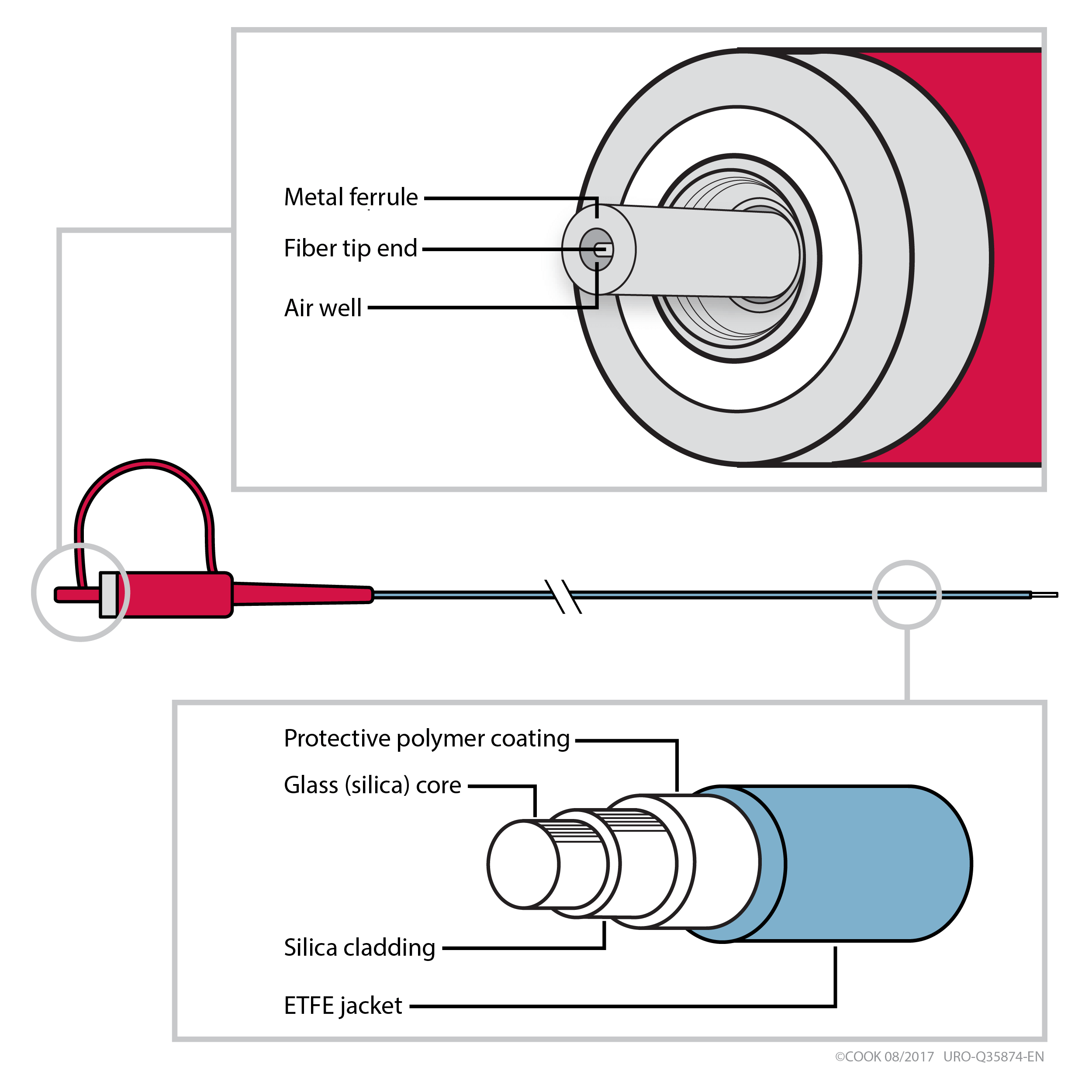A holmium:YAG (Ho:YAG) laser system transmits laser energy to the surgical site through a flexible fiberoptic delivery system called a laser fiber (or just a fiber). While fibers may vary somewhat in the features they offer, the science behind the delivery of the laser energy is similar from one fiber to the next.
Fiber hub
 The proximal end—or hub—of the laser fiber has a threaded coupler to establish a secure connection. A stainless-steel ferrule aligns the fiberoptic with the optical output on the laser system. Different laser systems accept different shapes of ferrules, and this is one of the factors that determines fiber compatibility. The SMA-905 connector is commonly used across the industry and can provide cross-compatibility for laser systems and fibers.
The proximal end—or hub—of the laser fiber has a threaded coupler to establish a secure connection. A stainless-steel ferrule aligns the fiberoptic with the optical output on the laser system. Different laser systems accept different shapes of ferrules, and this is one of the factors that determines fiber compatibility. The SMA-905 connector is commonly used across the industry and can provide cross-compatibility for laser systems and fibers.
Some fibers, like Cook Medical’s Holmium Laser Fibers, have the added benefit of an integrated protective material (quartz insert) in the hub of the fiber to absorb errant laser blasts and protect the optical deck on the laser system from damage. This protective material makes the laser system’s blast shield a redundant measure.*
Another engineering design often used at the hub to protect a fiber from damage is an air well termination, also known as a well connector. Cook’s fibers feature an air well termination.
Transmitting the energy
Pulsed laser energy from the optical deck on the laser system is focused into the fiber core, which is made from transparent glass (silica). A thin cladding of a secondary reflective silica with a slightly lower index of refraction surrounds the core. The laser energy travels the length of the fiber using the principle of total internal reflection—meaning all the laser energy is confined within the more optically dense medium (core) and reflects off the less optically dense medium (cladding) while traveling along the length of fiber.
In some fibers, like Cook Medical’s Holmium Laser Fibers, a thin polymer coating surrounds the cladding to help protect the glass core and cladding from damage as the fiber bends. An ETFE jacket adds an outer layer of durability to each fiber and protects the inner lumen of the endoscope from friction. The jacket ends a few millimeters before the working end (distal tip), but the coated cladding extends the length of the fiber to ensure the laser energy is directed to the area of treatment.
Sizes
Fibers come in multiple colors and sizes, depending on their manufacturer. The diameter of the fiber’s core is a major factor that determines how much energy can be transmitted through the fiber. The smaller the fiber, the more flexible it is, but also the less power it can transmit. Many manufacturers choose to list the size of their fibers according to the outer diameter of the fiber core. See the spec table for Cook’s fibers below as an example.
| Fiber size |
Connector color | Fiber core OD (+/- 2%) |
Overall fiber OD (+/- 5%) |
|||
| μm | Single-use | Multi-use | μm | Fr | μm | Fr |
| 150 | Red | — | 140 | .44 | 270 | .81 |
| 200 | Red | — | 200 | .60 | 375 | 1.13 |
| 273 | Red | Green | 272 | .82 | 420 | 1.26 |
| 365 | Red | Blue | 365 | 1.1 | 550 | 1.65 |
| 550 | Red | Violet | 550 | 1.65 | 750 | 2.25 |
| 940 | Red | Orange | 940 | 2.82 | 1400 | 4.2 |
Number of uses
The majority of laser fibers are intended for one-time use. However, there are also multi-use options. The number of uses depends on how carefully the fiber is handled and reprocessed. Specific step-by-step instructions must be followed to properly reprocess a fiber for reuse. The cutting, stripping, cleaving, and sterilization necessary to return a fiber to satisfactory working condition requires exacting precision.
Lase smarter
Cook’s Holmium Laser Fibers with SmartSync® Technology provide an advanced level of functionality when used with the Rhapsody H-30® Holmium Laser System. The SmartSync microchip within the fiber communicates with the Rhapsody H-30 laser to identify the size of the attached fiber, limit the laser energy to the fiber’s maximum allowable power output, and record laser information to facilitate troubleshooting (confidential patient data are not collected).
*Only available on fibers with diameters smaller than 550 µm.